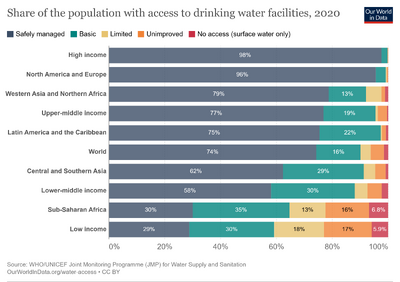Daily consumption of drinking water
The recommended amount of drinking water for human consumption per day is variable.[1] It depends on physical activity, age, health, and environmental conditions. In the United States, the Adequate Intake for total water, based on median intakes, is 3.7 litres (130 imp fl oz; 130 US fl oz) per day for human males older than 18, and 2.7 litres (95 imp fl oz; 91 US fl oz) per day for human females older than 18 which includes about 80% from beverages and 20% from food.[2] The European Food Safety Authority recommends 2.0 litres (70 imp fl oz; 68 US fl oz) of total water per day for adult women and 2.5 litres (88 imp fl oz; 85 US fl oz) per day for adult men.[3]
The common advice to drink 8 glasses (1,900 mL or 64 US fl oz) of plain water per day is not based on science, and an individual's thirst provides a better guide for how much water they require rather than a specific, fixed quantity.[4] Americans age 21 and older, on average, drink 1,043 mL (36.7 imp fl oz; 35.3 US fl oz) of drinking water a day and 95% drink less than 2,958 mL (104.1 imp fl oz; 100.0 US fl oz) per day.[5] Physical exercise and heat exposure cause loss of water and therefore may induce thirst and greater water intake.[6] Physically active individuals in hot climates may have total daily water needs of 6 litres (210 imp fl oz; 200 US fl oz) or more.[6]
The drinking water contribution to mineral nutrients intake is also unclear. Inorganic minerals generally enter surface water and ground water via storm water runoff or through the Earth's crust. Treatment processes also lead to the presence of some minerals. Examples include calcium, zinc, manganese, phosphate, fluoride and sodium compounds.[7] Water generated from the biochemical metabolism of nutrients provides a significant proportion of the daily water requirements for some arthropods and desert animals, but provides only a small fraction of a human's necessary intake. There are a variety of trace elements present in virtually all potable water, some of which play a role in metabolism. For example, sodium, potassium and chloride are common chemicals found in small quantities in most waters, and these elements play a role in body metabolism. Other elements such as fluoride, while beneficial in low concentrations, can cause dental problems and other issues when present at high levels.
Fluid balance is key. Profuse sweating can increase the need for electrolyte (salt) replacement. Water intoxication (which results in hyponatremia), the process of consuming too much water too quickly, can be fatal.[8] Water makes up about 60% of the body weight in men and 55% of weight in women.[9] A baby is composed of about 70% to 80% water while the elderly are composed of around 45%.[10]
See also
References
- ↑ Ann C. Grandjean (August 2004). "3" (PDF). Water Requirements, Impinging Factors, & Recommended Intakes. World Health Organization. pp. 25–34. Archived (PDF) from the original on 22 February 2016. This 2004 article focuses on the USA context and uses data collected from the US military.
- ↑ "US daily reference intake values". Iom.edu. Archived from the original on 6 October 2011. Retrieved 5 December 2011.
- ↑ EFSA Panel on Dietetic Products, Nutrition, and Allergies (2010). "Scientific Opinion on Dietary Reference Values for water". EFSA Journal. 8 (3): 1459. doi:10.2903/j.efsa.2010.1459.
{{cite journal}}: CS1 maint: multiple names: authors list (link) - ↑ H. Valtin, Drink at least eight glasses of water a day." Really? Is there scientific evidence for "8 × 8"? Archived 20 April 2010 at the Wayback Machine Am J Physiol Regul Integr Comp Physiol 283: R993-R1004, 2002.
- ↑ Exposure Factors Handbook: 2011 Edition (PDF). National Center for Environmental Assessment. September 2011. Archived from the original (PDF) on 24 September 2015. Retrieved 24 May 2015.
- ↑ 6.0 6.1 "Report Sets Dietary Intake Levels for Water, Salt, and Potassium To Maintain Health and Reduce Chronic Disease Risk". US Institute of Medicine, Food and Nutrition Board. 11 February 2004. Archived from the original on 13 September 2017. Retrieved 13 September 2017.
- ↑ World Health Organization Archived 19 January 2011 at the Wayback Machine (WHO). Geneva, Switzerland. Joyce Morrissey Donohue, Charles O. Abernathy, Peter Lassovszky, George Hallberg. "The contribution of drinking-water to total dietary intakes of selected trace mineral nutrients in the United States." Draft, August 2004.
- ↑ Noakes, Timothy D.; Goodwin, Neil; Rayner, Brian L.; Branken, Trevor; Taylor, Robert K.N. (2005). "Water Intoxication: A Possible Complication During Endurance Exercise☆". Wilderness & Environmental Medicine. 16 (4): 221–227. doi:10.1580/1080-6032(2005)16[221:WIAPCD]2.0.CO;2. PMID 16366205. S2CID 28370290. Archived from the original on 2022-12-22. Retrieved 2023-06-03.
- ↑ Miller, Thomas A. (2006). Modern surgical care physiologic foundations and clinical applications (3rd ed.). New York: Informa Healthcare. p. 34. ISBN 978-1-4200-1658-1. Archived from the original on 1 September 2017.
- ↑ Nancy caroline's emergency care in the streets (07 ed.). [S.l.]: Jones And Bartlett Learning. 2012. p. 340. ISBN 978-1-4496-4586-1. Archived from the original on 1 September 2017.
